Content for TS 38.413 Word version: 18.2.0
1…
4…
8…
8.2…
8.2.3…
8.3…
8.3.4…
8.4…
8.4.3…
8.5…
8.7…
8.8…
8.10…
8.12…
8.17…
9…
9.2…
9.2.2…
9.2.3…
9.2.4…
9.2.6…
9.2.7…
9.2.9…
9.2.11…
9.2.16…
9.2.17…
9.3…
9.3.1.21…
9.3.1.41…
9.3.1.61…
9.3.1.81…
9.3.1.101…
9.3.1.121…
9.3.1.141…
9.3.1.161…
9.3.1.181…
9.3.1.205…
9.3.1.222…
9.3.1.245…
9.3.2…
9.3.3…
9.3.3.21…
9.3.3.42…
9.3.4…
9.3.4.10…
9.3.5…
9.4…
9.4.4
9.4.5
9.4.6…
9.5…
10…
8.17 Broadcast Session Management Procedures
8.17.1 Broadcast Session Setup
8.17.2 Broadcast Session Modification
8.17.3 Broadcast Session Release
8.17.4 Broadcast Session Release Required
8.17.5 Broadcast Session Transport
8.18 Multicast Session Management Procedures
8.18.1 Distribution Setup
8.18.2 Distribution Release
8.18.3 Multicast Session Activation
8.18.4 Multicast Session Deactivation
8.18.5 Multicast Session Update
8.19 Timing Synchronisation Status Reporting Procedures
8.19.1 Timing Synchronisation Status
8.19.2 Timing Synchronisation Status Report
...
...
8.17 Broadcast Session Management Procedures |R17| p. 124
8.17.1 Broadcast Session Setup p. 124
8.17.1.1 General p. 124
The purpose of the Broadcast Session Setup procedure is to request the NG-RAN node to setup MBS session resources for a broadcast MBS session. The procedure uses non-UE associated signalling.
8.17.1.2 Successful Operation p. 124
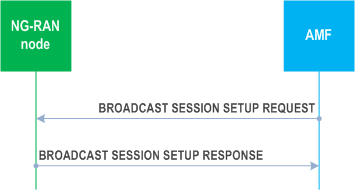
The AMF initiates the procedure by sending a BROADCAST SESSION SETUP REQUEST message to the NG-RAN node. If the NG-RAN node accepts all the MBS QoS flows in the MBS session at least in one of its cells, the NG-RAN node responds with the BROADCAST SESSION SETUP RESPONSE message.
If the MBS Service Area IE is included in the BROADCAST SESSION SETUP REQUEST message, the NG-RAN node shall take it into account as specified in TS 23.247.
If the MBS Session FSA ID List IE is included in the BROADCAST SESSION SETUP REQUEST message, the NG-RAN node shall take it into account to determine cells/frequencies within the MBS service area to broadcast MBS session data as specified in TS 23.247.
If the Supported UE Type List IE is included in the BROADCAST SESSION SETUP REQUEST message, the NG-RAN node shall, if supported, take it into account for configuring MBS session resources.
If the Associated Session ID IE is included in the BROADCAST SESSION SETUP REQUEST message the NG-RAN node shall, if supported, take this information into account to determine whether MBS session resource sharing is possible, as specified in TS 38.300.
8.17.1.3 Unsuccessful Operation p. 125
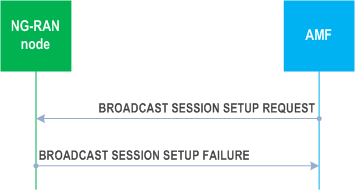
If the NG-RAN node is not able to provide the requested MBS session resources for all the MBS QoS flows in the MBS session in any of its cells, it shall send the BROADCAST SESSION SETUP FAILURE message.
8.17.1.4 Abnormal Conditions p. 125
Void.
8.17.2 Broadcast Session Modification p. 125
8.17.2.1 General p. 125
The purpose of the Broadcast Session Modification procedure is to request the NG-RAN node to update the MBS session resources or the area related to a previously established broadcast MBS session. The procedure uses non-UE associated signalling.
8.17.2.2 Successful Operation p. 125
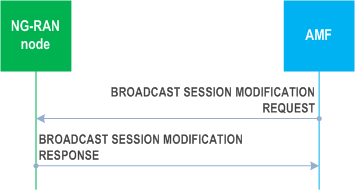
The AMF initiates the procedure by sending a BROADCAST SESSION MODIFICATION REQUEST message to the NG-RAN node.
If the MBS Service Area IE is included in the BROADCAST SESSION MODIFICATION REQUEST message, the NG-RAN node shall update the MBS service area and send the BROADCAST SESSION MODIFICATION RESPONSE message.
If the MBS Session Modification Request Transfer IE is included in the BROADCAST SESSION MODIFICATION REQUEST message, the NG-RAN node shall replace the previously provided information by the newly received one and update the MBS session resources and area as requested and send the BROADCAST SESSION MODIFICATION RESPONSE message.
If the Supported UE Type List IE is included in the BROADCAST SESSION MODIFICATION REQUEST message, the NG-RAN node shall, if supported, take it into account for configuring MBS session resources.
If the MBS NG-U Failure Indication IE is included in the BROADCAST SESSION MODIFICATION REQUEST message within the MBS Session Setup or Modification Request Transfer IE and set to "N3mb path failure", the NG-RAN node may provide new NG-U transport layer information to replace the failed one(s) or switch the data delivery to another 5GC as per the Broadcast MBS session restoration procedure for N3mb Path Failure specified in TS 23.527.
8.17.2.3 Unsuccessful Operation p. 126
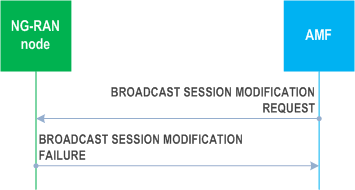
If the NG-RAN node fails to update any requested modification, the NG-RAN node shall send the BROADCAST SESSION MODIFICATION FAILURE message.
8.17.2.4 Abnormal Conditions p. 126
Void.
8.17.3 Broadcast Session Release p. 126
8.17.3.1 General p. 126
The purpose of the Broadcast Session Release procedure is to release the MBS session resources related to a previously established broadcast MBS session. The procedure uses non-UE assocated signalling.
8.17.3.2 Successful Operation p. 126
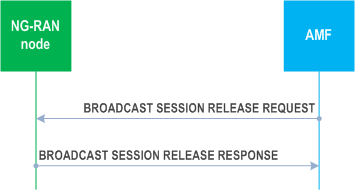
The AMF initiates the procedure by sending a BROADCAST SESSION RELEASE REQUEST message to the NG-RAN node.
Upon reception of the BROADCAST SESSION RELEASE REQUEST message, the NG-RAN node shall respond with the BROADCAST SESSION RELEASE RESPONSE message. The NG-RAN node node shall stop broadcasting and release all MBS session resources associated with the broadcast session.
Upon reception of the BROADCAST SESSION RELEASE RESPONSE message, the AMF shall transfer transparently the Broadcast Session Release Response Transfer IE, if available, to the MB-SMF.
8.17.3.3 Unsuccessful Operation p. 127
Not applicable.
8.17.3.4 Abnormal Conditions p. 127
Void.
8.17.4 Broadcast Session Release Required p. 127
8.17.4.1 General p. 127
The purpose of the Broadcast Session Release Required procedure is to trigger the AMF to release the MBS session resources related to a previously established broadcast MBS session. The procedure uses non-UE associated signalling.
8.17.4.2 Successful Operation p. 127
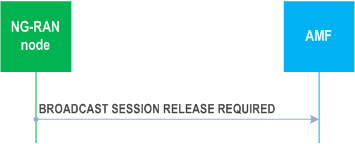
The NG-RAN node initiates the procedure by sending a BROADCAST SESSION RELEASE REQUIRED message to the AMF.
Upon reception of the BROADCAST SESSION RELEASE REQUIRED message, the AMF shall realize that the NG-RAN node is lacking adequate MBS session resources for a previously established broadcast MBS session and initiate the release of the MBS session resources.
8.17.4.3 Abnormal Conditions p. 127
Void.
8.17.5 Broadcast Session Transport |R18| p. 127
8.17.5.1 General p. 127
The purpose of the Broadcast Session Transport procedure is to assign NG-U resources for a broadcast MBS session. The procedure uses non-UE associated signalling.
8.17.5.2 Successful Operation p. 128
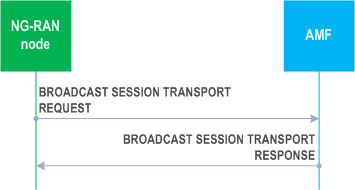
The NG-RAN node initiates the procedure by sending a BROADCAST SESSION TRANSPORT REQUEST message to the AMF. The AMF responds with a BROADCAST SESSION TRANSPORT RESPONSE message.
If the Shared NG-U Unicast TNL Information IE is included in the MBS Session TNL Information NG-RAN IE within the MBS Session Transport Request Transfer IE in the BROADCAST SESSION TRANSPORT REQUEST message, the MB-SMF shall use the included information as the downlink termination point for the shared NG-U transport.
8.17.5.3 Unsuccessful Operation p. 128
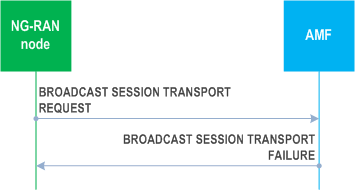
In case the shared NG-U transport cannot be setup successfully, the AMF shall respond with the BROADCAST SESSION TRANSPORT FAILURE message to the NG-RAN node with an appropriate cause value.
8.17.5.4 Abnormal Conditions p. 128
Void.
8.18 Multicast Session Management Procedures |R17| p. 128
8.18.1 Distribution Setup p. 128
8.18.1.1 General p. 128
The purpose of the Distribution Setup procedure is to assign NG-U resources for a multicast MBS session. The procedure uses non-UE-associated signalling.
8.18.1.2 Successful Operation p. 129
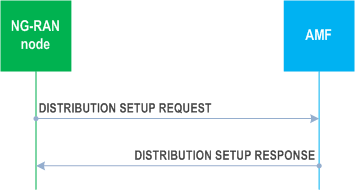
The NG-RAN node initiates the procedure by sending a DISTRIBUTION SETUP REQUEST message to the AMF. The AMF responds with a DISTRIBUTION SETUP RESPONSE message.
For location dependent multicast sessions, the NG-RAN node shall include the MBS Area Session ID IE in the DISTRIBUTION SETUP REQUEST message, and the AMF shall provide the same value of the MBS Area Session ID IE in the DISTRIBUTION SETUP RESPONSE message.
If the Shared NG-U Unicast TNL Information IE is included in the MBS Distribution Setup Request Transfer IE in the DISTRIBUTION SETUP REQUEST message, the MB-SMF shall use the included information as the downlink termination point for the shared NG-U transport.
If the Shared NG-U Unicast TNL Information IE is not included in the MBS Distribution Setup Request Transfer IE in the DISTRIBUTION SETUP REQUEST message, the MB-SMF shall interpret that the IP multicast is used for this shared NG-U transport, and include the Shared NG-U Multicast TNL Information IE in the MBS Distribution Setup Response Transfer IE in the DISTRIBUTION SETUP RESPONSE message.
8.18.1.3 Unsuccessful Operation p. 129
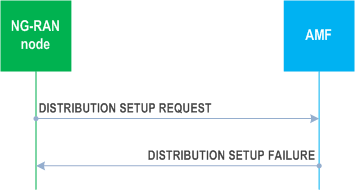
In case the shared NG-U transport cannot be setup successfully, the AMF shall respond with the DISTRIBUTION SETUP FAILURE message to the NG-RAN node with an appropriate cause value.
8.18.1.4 Abnormal Conditions p. 129
Void.
8.18.2 Distribution Release p. 129
8.18.2.1 General p. 129
The purpose of the Distribution Release procedure is to enable the release of already established NG-U resources for a given multicast MBS session, or for a given area session of the multicast MBS session. The procedure uses non-UE-associated signalling.
8.18.2.2 Successful Operation p. 130
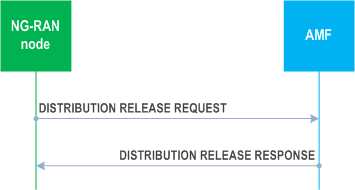
The NG-RAN node initiates the procedure by sending a DISTRIBUTION RELEASE REQUEST message.
Upon receipt of the DISTRIBUTION RELEASE REQUEST message, the AMF shall send the DISTRIBUTION RELEASE RESPONSE message after successfully removing the corresponding NG-U resource for the MBS session.
For location dependent multicast session, the NG-RAN node shall include the MBS Area Session ID IE in the DISTRIBUTION RELEASE REQUEST message, and the AMF shall provide the same value of the MBS Area Session ID IE in the DISTRIBUTION RELEASE RESPONSE message.
If unicast shared NG-U transport is used, the NG-RAN node shall include the Shared NG-U TNL Information IE in the MBS Distribution Release Request Transfer IE in the DISTRIBUTION RELEASE REQUEST message, and the MB-SMF shall release the corresponding shared NG-U transport as specified in TS 23.247.
8.18.2.3 Unsuccessful Operation p. 130
Not applicable.
8.18.2.4 Abnormal Conditions p. 130
Void.
8.18.3 Multicast Session Activation p. 130
8.18.3.1 General p. 130
The purpose of the Multicast Session Activation procedure is to request a NG-RAN node to activate the MBS session resources of a multicast MBS session. The procedure uses non-UE-associated signalling.
8.18.3.2 Successful Operation p. 131
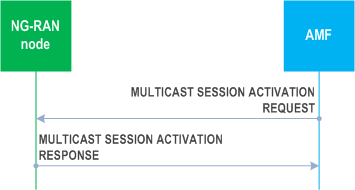
The AMF initiates the procedure by sending a MULTICAST SESSION ACTIVATION REQUEST message to the NG-RAN node.
Upon receipt of the MULTICAST SESSION ACTIVATION REQUEST, the NG-RAN node activates the previously requested MBS session resources corresponding to the MBS session indicated in the MULTICAST SESSION ACTIVATION REQUEST message and indicates in the MULTICAST SESSION ACTIVATION RESPONSE message for which MBS session the request was fulfilled.
8.18.3.3 Unsuccessful Operation p. 131
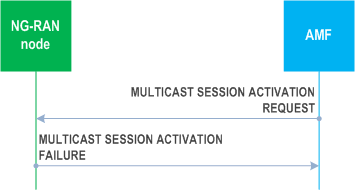
If the NG-RAN node cannot activate the previously requested MBS session resources indicated by the MULTICAST SESSION ACTIVATION REQUEST message, it shall respond with a MULTICAST SESSION ACTIVATION FAILURE message with an appropriate cause value.
8.18.3.4 Abnormal Conditions p. 131
Void.
8.18.4 Multicast Session Deactivation p. 132
8.18.4.1 General p. 132
The purpose of the Multicast Session Deactivation procedure is to request a NG-RAN node to deactivate the multicast MBS session resources of one MBS session. The procedure uses non-UE-associated signalling.
8.18.4.2 Successful Operation p. 132
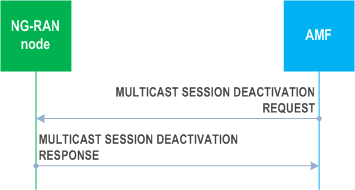
The AMF initiates the procedure by sending a MULTICAST SESSION DEACTIVATION REQUEST message to the NG-RAN node.
Upon receipt of this message, the NG-RAN node shall deactivate the previously requested MBS session resources corresponding to the MBS session indicated in the MULTICAST SESSION DEACTIVATION REQUEST message if the MBS resources are active and shall indicate in the MULTICAST SESSION DEACTIVATION RESPONSE message for which MBS session the request was fulfilled.
8.18.4.3 Unsuccessful Operation p. 132
Not applicable.
8.18.4.4 Abnormal Conditions p. 132
Void.
8.18.5 Multicast Session Update p. 132
8.18.5.1 General p. 132
The purpose of the Multicast Session Update procedure is to request the NG-RAN node to update the NG-RAN MBS session resources or area related to a multicast MBS session. The procedure uses non-UE associated signalling.
8.18.5.2 Successful Operation p. 133
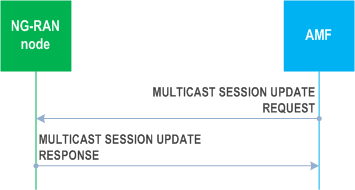
The AMF initiates the procedure by sending a MULTICAST SESSION UPDATE REQUEST message to the NG-RAN node.
Upon receipt of the MULTICAST SESSION UPDATE REQUEST message, the NG-RAN node shall, if requested, update the MBS QoS profile and/or MBS Service Area for the multicast service and send the MULTICAST SESSION UPDATE RESPONSE message to the AMF.
For location dependent multicast session, the AMF shall include the MBS Area Session ID IE in the MULTICAST SESSION UPDATE REQUEST message, and the NG-RAN node shall provide the same value of the MBS Area Session ID IE in the MULTICAST SESSION UPDATE RESPONSE message.
In case the MBS Service Area Information IE is included in the Multicast Session Update Request Transfer IE in the MULTICAST SESSION UPDATE REQUEST message, the NG-RAN node shall update the stored MBS Service Area Information for that service, as specified in TS 23.247.
In case the MBS QoS Flows To Be Setup or Modify List IE is included in the Multicast Session Update Request Transfer IE in the MULTICAST SESSION UPDATE REQUEST message, the NG-RAN node shall setup or modify the MBS QoS profile accordingly.
In case the MBS QoS Flows To Be Release List IE is included in the Multicast Session Update Request Transfer IE in the MULTICAST SESSION UPDATE REQUEST message, the NG-RAN node shall release the indicated MBS QoS flows.
In case the MBS Session TNL Information 5GC IE is included in the Multicast Session Update Request Transfer IE in the MULTICAST SESSION UPDATE REQUEST message, the NG-RAN node shall take the information into account and update related NG-U resources.
8.18.5.3 Unsuccessful Operation p. 134
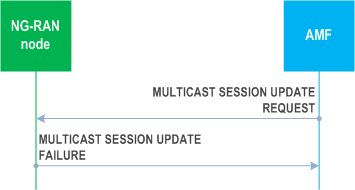
If the NG-RAN node is not able to perform any of the requested update, it shall respond with a MULTICAST SESSION UPDATE FAILURE message with an appropriate cause value.
8.18.5.4 Abnormal Conditions p. 134
Void.
8.19 Timing Synchronisation Status Reporting Procedures |R18| p. 134
8.19.1 Timing Synchronisation Status p. 134
8.19.1.1 General p. 134
The purpose of the Timing Synchronisation Status procedure is to enable the AMF to request the NG-RAN node to start or stop reporting of RAN timing synchronisation status information as specified in TS 23.501 and TS 23.502. The procedure uses non-UE associated signalling.
8.19.1.2 Successful Operation p. 134
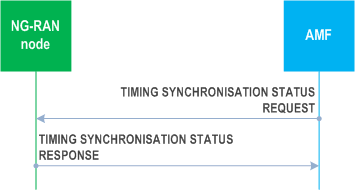
The AMF initiates the procedure by sending a TIMING SYNCHRONISATION STATUS REQUEST message to the NG-RAN node.
If the RAN TSS Request Type IE included in the TIMING SYNCHRONISATION STATUS REQUEST message is set to "start", the NG-RAN node shall start the RAN TSS reporting for the TSCTSF indicated by the Routing ID IE. If the RAN TSS Request Type IE is set to "stop", the NG-RAN node shall stop the reporting for the TSCTSF indicated by the Routing ID IE.
8.19.1.3 Unsuccessful Operation p. 135
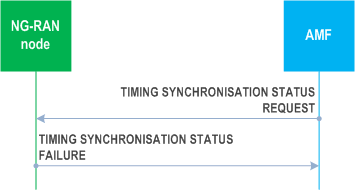
If the NG-RAN node is not able to report timing synchronisation status, it shall consider the procedure as failed and reply with the TIMING SYNCHRONISATION STATUS FAILURE message.
8.19.1.4 Abnormal Conditions p. 135
Void.
8.19.2 Timing Synchronisation Status Report p. 135
8.19.2.1 General p. 135
The purpose of the Timing Synchronisation Status Report procedure is to enable the NG-RAN node to provide RAN timing synchronisation status information to the AMF as specified in TS 23.501 and TS 23.502. The procedure uses non-UE associated signalling.
8.19.2.2 Successful Operation p. 135
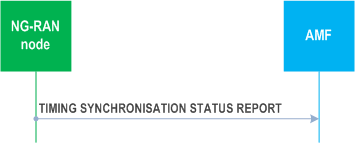
The NG-RAN node initiates the procedure by sending a TIMING SYNCHRONISATION STATUS REPORT message to the AMF for the TSCTSF indicated by the Routing ID IE.
8.19.2.3 Abnormal Conditions p. 135
Void.